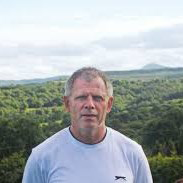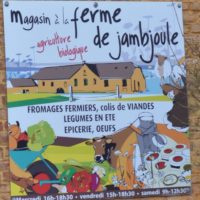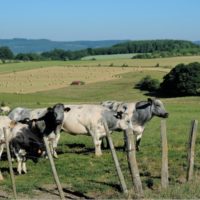Grass-measuring using the Grasshopper and PastureBase Ireland
Farm: “Ger Dineen”
Location: Macroom, Co. Cork, Ireland
Case study
 Grass-measuring using the Grasshopper and PastureBase Ireland (.pdf)
Grass-measuring using the Grasshopper and PastureBase Ireland (.pdf)
Description
Background
I am married to Gobnait and have four children, Muireann, Ciara, Danial and Ciaran. I also wish to acknowledgethe support over the years of my wife Gobnait and the continued help of my children who have always lent a hand when required. I have around 60 suckler cows and finish the bulls under 16 months with surplus heifers sold for breeding. AI is carried out on all my cows, which I do myself, and keep around 20% for replacements. All cows and heifers are bred to high index maternal sires. I am using Simmental, Saler, Angus, Limousin and this year, Shorthorn. I am also using Fleckvieh and Simmental for more milk.
I farm around 50 hectares in West Cork. I have 12 hectares of forestry on the poorer ground and 32 adjusted hectares of grassland. My farm is 2/3 dry ground and 1/3 heavy ground. Grassland management has become a key driver to the business over the past few years. Emphasis has been placed on prolonging the grazing season, reducing feed costs and increasing animal performance as a means of increasing output and profitability.
Paddocks are closed on the 10th of October on rotation and all animals are in by the 1st of December, if weather permits. I calf to grass, cows and heifers start calving around the 1st of February and go straight out if the weather is ok but will come in again if they are doing a lot of damage. All cows are
calved by the 1st of April, you now have a bunch of calves only 8 weeks apart. I have only one group of animals on my farm, cows and bulling heifers are run together to make it easier for AI.
I won Beef Grassland Farmer of the Year in 2017, growing an average 14 tonne per hectare in the previous year. My farm is good to grow grass when all the conditions are right. However the grass growing year of 2012 and spring of 2013 were awful, and now the fall of 2017 and spring of 2018 were even worse. However the farm was growing around 7 tonne per hectare in 2012. In 2016, I was growing an average of 14 tonne per hectare. It was like having an extra farm next to me and my stocking rate went from 1.4 to 2.4 LU/ha.
Detailed description
All my soil samples were low for P and K at the start of 2012, now they are at index 3 for P and K and lime is around 6.7. I also soil sample every 3 years. I reseed around 10-15% of my farm every year. I walk the farm and measure my grass every week using the Grasshopper and upload it to PastureBase Ireland. The Grasshopper is an electronic platemeter that calculates kgDM/ha using a GPS system. On PastureBase you can see the paddocks that are doing well and the ones that are preforming poorly. Last year my paddocks ranged from 8-18 tonne per hectare. At €105 per tonne for every additional tonne of grass utilised, this All my soil samples were low for P and K at the start of 2012, now they are at index 3 for P and K and lime is around 6.7. I also soil sample every 3 years. I reseed around 10-15% of my farm every year. I walk the farm and measure my grass every week using the Grasshopper and upload it to PastureBase Ireland. The Grasshopper is an electronic platemeter that calculates kgDM/ha using a GPS system. On PastureBase you can see the paddocks that are doing well and the ones that are preforming poorly. Last year my paddocks ranged from 8-18 tonne per hectare. At €105 per tonne for every additional tonne of grass utilised, this means that the 8 tonne paddock is producing €840 of grass per hectare and the 18 tonne is producing €1890 per hectare. That’s a difference of €1050. The paddocks that are growing only 8 tonne per hectare are ok in Lime, P and K but it is cold peaty ground. I also cut a lot of round bales of silage to keep grass in good condition. If a paddock is getting strong I will take it out if I have plenty of grass. This is where the PastureBase package comes in. It will tell you how much grass you have on the farm at all times. I cut around 5 bales per acre, most people think this is crazy but I feed the bales to the finishing bulls as they are around 75 DMD +. These bales save me around 1 tonne of ration per bull. Before I used the bales, I fed the bulls 2.5 tonne of ration. Now I feed 1.5 tonne /hd at €250 a tonne for ration which is worth €7500 for 30 bulls. I make between 200 and 400 bales every year keeping grazing paddocks in good condition.
My farm has 32 paddocks, roughly 1 hectare each. The more paddocks you have the more control you have over grass. I also have roadways running to most paddocks and every year I am putting in more roadways. It is easy to grow grass but to graze to 4cm is the hard part. It was a tough year this spring to do that. I have lots of ways to do this but they all take time. The way I look at it is, it costs me around €1200 a week to keep my cattle inside. If I can get them out earlier and keep them out longer it will pay off. If I got €1200 a week to put up wires and move stock in and out in bad weather it is a difference between making money and losing it. In very bad weather cows and bulling heifers will be left out for 3 hours a day to save silage. I will put cattle out full time and block graze every 12 hours if they are not doing too much damage.
The suckler cows are separated from the calves 10 days before AI starts to get them cycling. The cows come in from the paddocks in the morning and evening to the calves. What I have found in bad weather is by letting the paddock wire open to the roadway, the cows are then waiting on the roadway to come into the calves. This way there is a lot less damage done to the paddock. When my cows and calves are grazing together all the wires in the paddocks are raised so the calves graze ahead of the cows. I have no creep feeder, my calves’ average 1.3kgs a day weight gain for the heifers and 1.5kgs for the males. Every 0.1kgs weight gain is worth €100 to me. When you are finishing bulls you should try and get them as heavy as you can before weaning them. Bulls at grass are costing 30cent per day, inside to be finished cost €3, that’s a huge saving.
I reseed around 10-15% of the farm every year, usually at the start of August, depending on how much grass I have. I pick the worst preforming paddocks and will drain it if it’s wet. I have a low cost method for reseeding. I will burn off the paddock, if it has lots of grass I will cut it and bale it after 5 days or else get cattle in to graze it tight. After 2 weeks I will use a spring harrow and give the paddock 2 runs to make a fine seed bed. The paddock will get Lime at 2 tonne per acre and 2 bags of 10-10-20. I will set the seed with a Vicon fertiliser spreader at 14kgs per acre. At the moment I am using Abergain (T), Aberchoice (D) and Drumbo (D). I will use up to 60% Tetraploid in dry ground and 40% in heavy ground and then the field is rolled. I will spray the paddock with an undersown spray to kill the seedling weeds. It will get 27 units of N/acre and I will graze it mid-September with weanlings and might get another grazing if the weather is ok. All this costs around €100 per acre, I think it pays off for itself in one year. Normally you get 2- 4 tonne/ha boost from reseeding which is worth around €105 per tonne utilised. For 2018 I will incorporate clover into some of my paddocks.
For me, the more grass I grow the more profit I make!
Adoption criteria
I walk the farm and measure my grass every week using the Grasshopper and upload it to PastureBase Ireland. The Grasshopper is an electronic platemeter that calculates kgDM/ha using a GPS system. On PastureBase you can see the paddocks that are doing well and the ones that are preforming poorly. Last year my paddocks ranged from 8-18 tonne per hectare. I also cut a lot of round bales of silage to keep grass in good condition. If a paddock is getting strong I will take it out if I have plenty of grass. This is where the PastureBase package comes in. It will tell you how much grass you have on the farm at all times.
Future prospects
My farm is good to grow grass when all the conditions are right. However the grass growing year of 2012 and spring of 2013 were awful, and now the fall of 2017 and spring of 2018 were even worse. However the farm was growing around 7 tonne per hectare in 2012. In 2016, I was growing an average of 14 tonne per hectare. It was like having an extra farm next to me and my stocking rate went from 1.4 to 2.4 LU/ha. I hope to continue this positive curve.
Additional information
| Farming system | conventional farming |
|---|---|
| Domains of innovation | animal type (breed), forage mixture, grazing management system, legume management – Perennial legumes |
| Main types of animal | beef cattle |
| Country | Ireland |
| Product type | Case study |
| Language | English |





